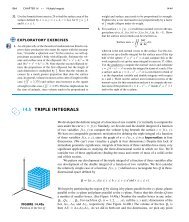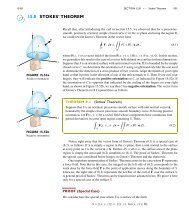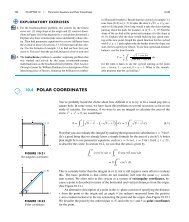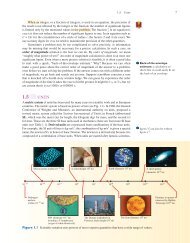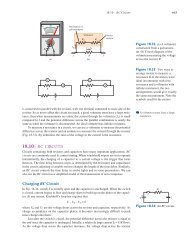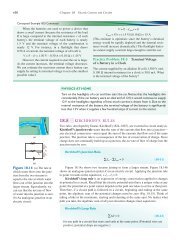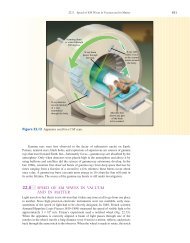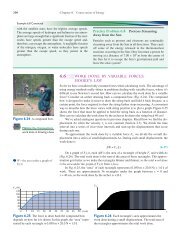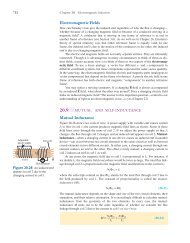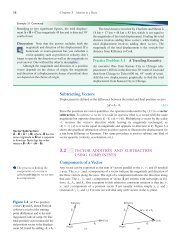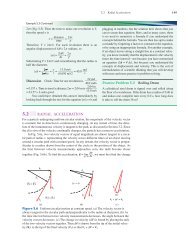TEMPERATURE SCALES Table 13.1
TEMPERATURE SCALES Table 13.1
TEMPERATURE SCALES Table 13.1
You also want an ePaper? Increase the reach of your titles
YUMPU automatically turns print PDFs into web optimized ePapers that Google loves.
13.2 Temperature Scales 455<br />
13.2 <strong>TEMPERATURE</strong> <strong>SCALES</strong><br />
Thermometers measure temperature by exploiting some property of matter that is temperature-dependent.<br />
The familiar liquid-in-glass thermometer relies on thermal expansion:<br />
the mercury or alcohol expands as its temperature rises (or contracts as its<br />
temperature drops) and we read the temperature on a calibrated scale. Since some materials<br />
expand more than others, these thermometers must be calibrated on a scale using<br />
some easily reproducible phenomenon, such as the melting point of ice or the boiling<br />
point of water. The assignment of temperatures to these phenomena is arbitrary.<br />
The most commonly used temperature scale in the world is the Celsius scale. On<br />
the Celsius scale, 0°C is the freezing temperature of water at P = 1 atm (the ice point)<br />
and 100°C is the boiling temperature of water at P = 1 atm (the steam point).<br />
In the United States, the Fahrenheit scale is still commonly used (Fig. 13.2). At<br />
1 atm, the ice point is 32°F and the steam point is 212°F, so the difference between the<br />
steam and ice points is 180°F. The size of the Fahrenheit degree interval is therefore<br />
smaller than the Celsius degree interval: a temperature difference of 1°C is equivalent to<br />
a difference of 1.8°F:<br />
° F<br />
∆T F = ∆T C × 1.8 (13-1)<br />
° C<br />
Since the two scales also have an offset (0°C is not the same temperature as 0°F) conversion<br />
between the two is:<br />
T F = (1.8°F/°C) T C + 32°F<br />
(13-2a)<br />
T C = T F – 32°<br />
F<br />
<br />
(13-2b)<br />
1.8°F/<br />
° C<br />
The SI unit of temperature is the kelvin (symbol K, without a degree sign). The<br />
kelvin has the same degree size as the Celsius scale; that is, a temperature difference of<br />
1°C is the same as a difference of 1 K. However, 0 K represents absolute zero—there<br />
are no temperatures below 0 K. The ice point is 273.15 K, so temperature in °C (T C ) and<br />
temperature in kelvins (T) are related.<br />
T C = T – 273.15 (13-3)<br />
Equation (13-3) is the definition of the Celsius scale in terms of the kelvin. <strong>Table</strong> <strong>13.1</strong><br />
shows some temperatures in kelvins, °C, and °F.<br />
Celsius<br />
100°C<br />
50°C<br />
0°C<br />
–40°C<br />
The freezing and boiling<br />
temperatures of water<br />
depend on the pressure.<br />
Fahrenheit<br />
212°F (Steam<br />
200°F point)<br />
150°F<br />
100°F<br />
50°F<br />
32°F (Ice point)<br />
0°F<br />
–40°F<br />
Figure 13.2 The Fahrenheit<br />
and Celsius temperature scales.<br />
<strong>Table</strong> <strong>13.1</strong><br />
Some Reference Temperatures in K, °C, and °F<br />
K °C °F K °C °F<br />
Absolute zero 0 –273.15 –459.67<br />
Lowest transient temperature<br />
achieved (laser cooling) 10 –9<br />
Intergalactic space 3 –270 –454<br />
Helium boils 4.2 –269 –452<br />
Nitrogen boils 77 –196 –321<br />
Carbon dioxide freezes<br />
(“dry ice”) 195 –78 –108<br />
Mercury freezes 234 –39 –38<br />
Ice melts/water freezes 273.15 0 32.0<br />
Human body temperature 310 37 98.6<br />
Water boils 373.15 100.00 212.0<br />
Campfire 1,000 700 1,300<br />
Gold melts 1,337 1,064 1,947<br />
Lightbulb filament 3,000 2,700 4,900<br />
Surface of Sun; iron<br />
welding arc 6,300 6,000 11,000<br />
Center of Earth 16,000 15,700 28,300<br />
Lightning channel 30,000 30,000 50,000<br />
Center of Sun 10 7 10 7 10 7<br />
Interior of neutron star 10 9 10 9 10 9
456 Chapter 13 Temperature and the Ideal Gas<br />
Example <strong>13.1</strong><br />
A Sick Friend<br />
A friend suffering from the flu has a fever; her<br />
body temperature is 38.6°C. What is her temperature<br />
in (a) K and (b) °F?<br />
Strategy (a) Kelvins and °C differ only by a shift of<br />
the zero point. Converting from °C to K requires only the<br />
addition of 273.15 K since 0°C (the ice point) corresponds<br />
to 273.15 K. (b) The °F is a different size than the<br />
°C, as well as having a different zero. In the Celsius<br />
scale, the zero is at the ice point. First multiply by<br />
1.8°F/°C to find how many °F above the ice point. Then<br />
add 32°F (the Fahrenheit temperature of the ice point).<br />
Solution (a) The temperature is 38.6 K above the ice<br />
point of 273.15 K. Therefore, the kelvin temperature is<br />
T = 38.6 K + 273.15 K = 311.8 K<br />
(b) First find how many °F above the ice point:<br />
∆T F = 38.6°C × (1.8°F/°C) = 69.5°F<br />
The ice point is 32°F, so<br />
T F = 32.0°F + 69.5°F = 101.5°F<br />
Discussion The answer is reasonable since 98.6°F is<br />
normal body temperature.<br />
Practice Problem <strong>13.1</strong> Normal Body<br />
Temperatures with Two Scales<br />
Convert the normal human body temperature (98.6°F) to<br />
degrees Celsius and kelvins.<br />
13.3 THERMAL EXPANSION OF SOLIDS AND LIQUIDS<br />
Most objects expand as their temperature increases. Long before the cause of thermal<br />
expansion was understood, the phenomenon was put to practical use. For example, the<br />
cooper (barrel maker) heated iron hoops red hot to make them expand before fitting<br />
them around the wooden staves of a barrel. The iron hoops contracted as they cooled,<br />
pulling the staves tightly together to make a leak-tight barrel.<br />
Recall that the fractional length change (strain) caused by a tensile or compressive<br />
stress is proportional to the stress that caused it [Eq. (10-4)]. Similarly, the fractional<br />
length change caused by a temperature change is proportional to the temperature change,<br />
as long as the temperature change is not too great. If the length of a wire, rod, or pipe is<br />
L 0 at temperature T 0 (Fig. 13.3), then<br />
∆ L<br />
= a ∆T (13-4)<br />
L<br />
0<br />
T 0<br />
T > T 0<br />
L 0<br />
Figure 13.3 Expansion of a<br />
solid rod with increasing<br />
temperature.<br />
L<br />
∆L<br />
where ∆L = L – L 0 and ∆T = T – T 0 . The length at temperature T is<br />
L = L 0 + ∆L = (1 + a ∆T) L 0 (13-5)<br />
The constant of proportionality a is called the coefficient of thermal expansion of<br />
the substance. It plays a role in thermal expansion similar to that of the elastic modulus<br />
in tensile stress. If T is measured in kelvins or in degrees Celsius, then a has units of K –1<br />
or °C –1 . Since only the change in temperature is involved in Eq. (13-4), either Celsius or<br />
Kelvin temperatures can be used to find ∆T; a temperature change of 1 K is the same as<br />
a temperature change of 1°C.<br />
As is true for the elastic modulus, the coefficient of thermal expansion has different<br />
values for different solids and also depends to some extent on the starting temperature<br />
of the object. <strong>Table</strong> 13.2 lists the coefficients of thermal expansion for various solids at<br />
room temperature (20°C).



